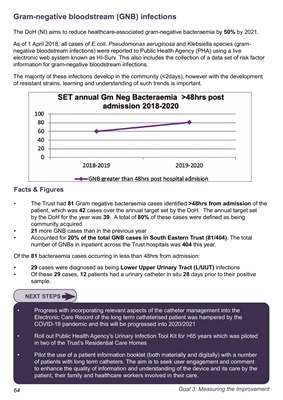
Gram-negative bloodstream (GNB) infections
The DoH (NI) aims to reduce healthcare-associated gram-negative bacteraemia by 50% by 2021.
As of 1 April 2018, all cases of E.coli. Pseudomonas aeruginosa and Klebsiella species (gramnegative bloodstream infections) were reported to Public Health Agency
(PHA) using a live
electronic web system known as HI-Surv. This also includes the collection of a data set of risk factor
information for gram-negative bloodstream infections.
The majority of these infections develop in the community (<2days), however with the development
of resistant strains, learning and understanding of such trends is important.
Facts & Figures
• The Trust had 81 Gram negative bacteraemia cases identified >48hrs from admission of the
patient, which was 42 cases over the annual target set by the DoH. The annual target set
by the DoH for the year was 39. A total of 80% of these cases were defined as being
community acquired
• 21 more GNB cases than in the previous year
• Accounted for 20% of the total GNB cases in South Eastern Trust (81/404). The total
number of GNBs in inpatient across the Trust hospitals was 404 this year.
Of the 81 bacteraemia cases occurring in less than 48hrs from admission:
• 29 cases were diagnosed as being Lower Upper Urinary Tract (L/UUT) infections
• Of these 29 cases, 12 patients had a urinary catheter in situ 28 days prior to their positive
sample.
• Progress with incorporating relevant aspects of the catheter management into the
Electronic Care Record of the long term catheterised patient was hampered by the
COVID-19 pandemic and this will be progressed into 2020/2021
• Roll out Public Health Agency's Urinary Infection Tool Kit for >65 years which was piloted
in two of the Trust's Residential Care Homes
• Pilot the use of a patient information booklet (both materially and digitally) with a number
of patients with long term catheters. The aim is to seek user engagement and comment
to enhance the quality of information and understanding of the device and its care by the
patient, their family and healthcare workers involved in their care.
NEXT STEPS
Goal 3: Measuring the Improvement
64